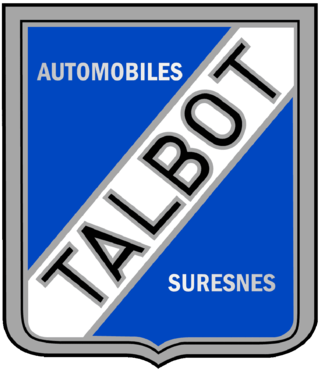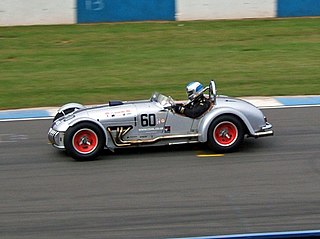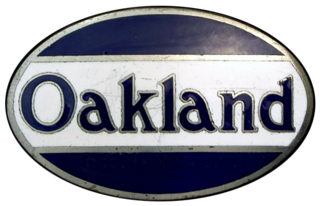
Bristol Cars was a British manufacturer of hand-built luxury cars headquartered in Bristol, England. It was formed from the car division of the Bristol Aeroplane Company after the Second World War and later became independent as Bristol Cars Limited. After being placed in receivership and being taken over in 2011, it entered liquidation in February 2020.

Allard Motor Company Limited was a London-based low-volume car manufacturer founded in 1945 by Sydney Allard in small premises in Clapham, south-west London. Car manufacture almost ceased within a decade. It produced approximately 1900 cars before it became insolvent and ceased trading in 1958. Before the war, Allard supplied some replicas of a Bugatti-tailed special of his own design from Adlards Motors in Putney.

The term 1932 Ford may refer to three models of automobile produced by Ford Motors between 1932 and 1934: the Model B, the Model 18, and the Model 40. These succeeded the Model A. The Model B had an updated four-cylinder engine and was available from 1932 to 1934. The V8 was available in the Model 18 in 1932, and in the Model 40 in 1933 & 1934. The 18 was the first Ford fitted with the flathead V-8. The company also replaced the Model AA truck with the Model BB, available with either the four- or eight-cylinder engine.

Riley was a British motorcar and bicycle manufacturer from 1890. Riley became part of the Nuffield Organization in 1938 and was merged into the British Leyland Motor Corporation in 1968. In July 1969 British Leyland announced the immediate end of Riley production, although 1969 was a difficult year for the UK automotive industry and many cars from Riley's inventory may have been first registered in 1970.

Earl William "Madman" Muntz was an American businessman and engineer who sold and promoted cars and consumer electronics in the United States from the 1930s until his death in 1987. He was a pioneer in television commercials with his oddball "Madman" persona; an alter ego who generated publicity with his unusual costumes, stunts, and outrageous claims. Muntz also pioneered car stereos by creating the Muntz Stereo-Pak, better known as the 4-track cartridge, a predecessor to the 8-track cartridge developed by Lear Industries.

Jensen Motors Limited was a British manufacturer of sports cars and commercial vehicles in West Bromwich, England. Brothers Alan and Richard Jensen gave the new name, Jensen Motors Limited, to the commercial- and sports car body-making business of W J Smith & Sons Limited in 1934. It ceased trading in 1976. Though trading would resume in 1998, Jensen Motors Limited was dissolved on 30 July 2011.
Frank Peter Kurtis was an American racing car designer. He designed and built midget cars, quarter-midgets, sports cars, sprint cars, Indy cars, and Formula One cars. He was the founder of Kurtis Kraft.

Talbot-Lago was a French automobile manufacturer based in Suresnes, Hauts de Seine, outside Paris. The company was owned and managed by Antonio Lago, an Italian engineer that acquired rights to the Talbot brand name after the demise of Darracq London's subsidiary Automobiles Talbot France in 1936.

Lea-Francis was a British motor manufacturing company that began by building bicycles.

Kurtis Kraft was an American designer and builder of race cars. The company built midget cars, quartermidgets, sports cars, sprint cars, Bonneville cars, and USAC Championship cars. It was founded by Frank Kurtis when he built his own midget car chassis in the late 1930s.

The Nash-Healey is a three-seat luxury sports car or grand tourer produced from 1951 to 1954. It was marketed by the Nash-Kelvinator conglomerate in North America as a halo car to promote sales of its Nash Motors division.

The Oakland Motor Car Company of Pontiac, Michigan, was an American automobile manufacturer and division of General Motors. Purchased by General Motors in 1909, the company continued to produce modestly priced automobiles until 1931 when the brand was dropped in favor of the division's Pontiac make.

Gordon-Keeble was a British car marque, conceived in Slough, then constructed in Eastleigh, and finally in Southampton, between 1964 and 1967. The marque's badge was unusual in featuring a tortoise — a pet tortoise walked into the frame of an inaugural photo-shoot, taken in the grounds of the makers. Because of the irony the animal was chosen as the emblem.

The Boss 429 Mustang is a high-performance Ford Mustang variant that was offered by Ford in 1969 and 1970.

In 2023, Spain produced 2.45 million cars which makes it the 8th largest automobile producer country in the world and the 2nd largest car manufacturer in Europe after Germany, a position in the ranking that it was still keeping in 2024.
Justice brothers were figures in motorsports and automotive industry. Founding a company in the oil additive industry.

The 1950s were pivotal for the American automobile industry. The post-World War II era brought a wide range of new technologies to the automobile consumer, and a host of problems for the independent automobile manufacturers. The industry was maturing in an era of rapid technological change; mass production and the benefits from economies of scale led to innovative designs and greater profits, but stiff competition between the automakers. By the end of the decade, the industry had reshaped itself into the Big Three, Studebaker, and AMC. The age of small independent automakers was nearly over, as most of them either consolidated or went out of business.

The Allard J2 is a sports roadster that was made by Allard. The J2 was mainly intended for the American market. Since 1981, replicas of the later J2X have been manufactured by a succession of companies in Canada, whilst a continuation of the original models is also now being produced in the UK.

The Muntz Jet is a two-door hardtop convertible built by the Muntz Car Company in the United States between approximately 1949 and 1954. It is sometimes credited as the first personal luxury car. Developed from the Kurtis Sport Car (KSC) that was designed by Frank Kurtis, it was produced and marketed by Earl "Madman" Muntz. The car was powered by one of two V8 engines, either a 160 hp (120 kW) Cadillac engine or a 160 hp (120 kW) Lincoln engine, and it was equipped with either a General Motors Hydramatic automatic transmission or a three-speed Borg-Warner manual transmission. The Jet was streamlined, featured numerous luxury appointments, and was equipped with safety features that were not standard on most cars of its day, including a padded dashboard and seat belts.

The Kurtis Sport Car (KSC) is a two-seat, aluminum-body sports car designed by Frank Kurtis and manufactured by Kurtis Kraft in 1949 and 1950. Built with numerous components from a 1949 Ford, the KSC was built as both a production car and a kit car. It was sold at a base price of $3,495. It could cost up to $5,000 with options, which was approximately $1,000 more than the then-new Jaguar XK120.





















